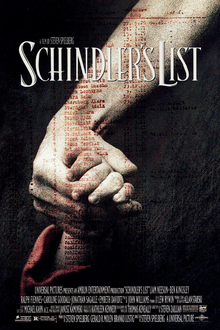Based on the novel Schindler's Ark, by the Australian novelist Thomas Keneally, the film was directed by Steven Spielberg and features notable actors such as Liam Neeson as Schindler, Ralph Fiennes as SS officer Amon Goth and Ben Kingsley as Schildler's Jewish accountant, Itzhak Stern.
The film was a box office success and recipient of seven Academy Awards including Best Picture, Best Director and Best Original Score as well as numerous other awards.

Although the film is primarily shot in black and white, red is used to distinguish a little girl in a coat. Later in the film, the girl is seen among the dead, recognizable only by the red coat she is still wearing.
The scene, however, was constructed on the memories of Zelig Burkhut, survivor of Plaszow (and other work camps). When interviewed by Spielberg before the film was made, Burkhut told of a young girl wearing a pink coat, no older than four, who was shot by a Nazi officer right before his eyes.
The girl in the red coat is used to indicate that Schindler has changed: Andre Caron wondered whether it was done "to symbolize innocence, hope or the red blood of the Jewish people being sacrificed in the horror of the Holocaust?"
Spielberg himself has explained that he only followed the novel, and his interpretation was that
- "America and Russia and England all knew about the Holocaust when it was happening, and yet we did nothing about it. We didn't assign any of our forces to stopping the march toward death, the inexorable march toward death. It was a large bloodstain, primary red color on everyone's radar, but no one did anything about it. And that's why I wanted to bring the color red in."
Sophia
No comments:
Post a Comment